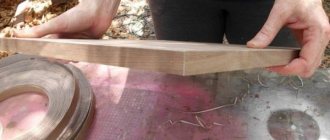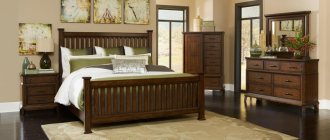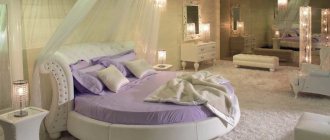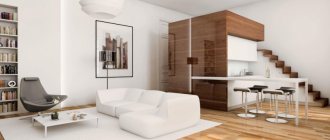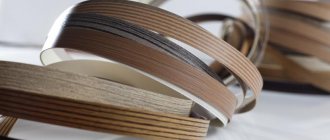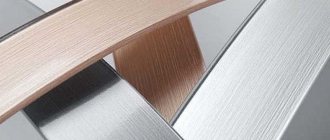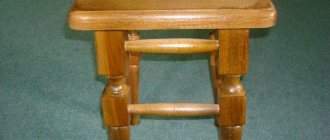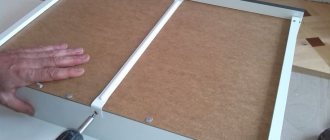Today, manufacturers of furniture structures use a large number of different materials to protect the end sections of products. The main purpose of furniture edges is to protect people from formaldehyde resin fumes. When making furniture structures, you need to make the right choice of material and know how to glue the edges at home.
Types of finishing
At the moment, there are several ways to give the ends of the tabletop an aesthetic appearance. Only 2 of them are suitable for making edges at home:
- Covering with melamine tape. Glue applied to the tape itself simplifies the process, but the resulting edge is susceptible to moisture and is not resistant to mechanical stress.
Today it is the cheapest and most accessible, therefore it is very often used in furniture production. - PVC strip trim. Requires more expense, but the edges are stronger.
Quite a popular furniture edge for cladding the end surfaces of laminated chipboards. All thanks to the ideal price-quality ratio.
What types of edges are there for furniture?
Edge materials hide the inside of the chipboard and extend the life of the furniture. Another task of the edges is to reduce the evaporation of the resins with which the slab material is impregnated. There are several requirements for edge materials:
- decent appearance - aesthetics;
- strength and durability;
- reliable fixation on the edge of furniture;
- ease of installation.
The materials offered by the industry fully comply with these requirements. All that remains is to choose.
Paper and melamine
A border made of paper impregnated with a special resin (melamine) is the most economical option for edge processing. Thick grades of paper are given additional strength and resistance to external influences using melamine. It is easy to work with such material - it does not break and bends at any angle.
The most common material thickness is 0.2 and 0.4 millimeters. For ease of use, the melamine edge is coated with adhesive that is activated when heated.
Melamine paper is not afraid of water and does not fade under the influence of the sun, and is resistant to scratches and household chemicals. The main disadvantage is that it wears out due to friction and is not durable. It is advisable to install such edges on areas of furniture that are not constantly exposed - on the back of shelves, tabletops.
PVC
Polyvinyl chloride is a durable material that has found application in various fields of activity, including medicine. PVC edges are suitable for finishing façade areas of furniture. The manufacturer produces the material in different colors, it is easy to choose an edge that matches the color of the product or a contrasting one.
- strength, long service life with high-quality stickers;
- flexibility - the ability to attach to furniture with any edge curvature;
- resistance to any type of influence - chemicals, sun, friction.
A large selection of materials in thickness (from 0.4 to 4 millimeters) and width allows you to create different types of furniture design. Polyvinyl chloride edging materials are available with an adhesive component or simple. The disadvantage of PVC edges is their sensitivity to temperatures - furniture should not be left in the cold, and when gluing it should not be heated too much.
Made from ABS plastic
Expensive types of edge material include ABS plastic. It is usually used on more expensive furniture models. The advantages of thermoplastic edges include:
- high quality material, absence of harmful components in the composition;
- impact and wear resistance;
- does not lose color or appearance during long-term use.
The edge is available in matte and glossy versions. The disadvantage of the material is the high price. ABS plastic is used when high durability is required, operation in aggressive environments - temperature, chemical exposure.
Veneer
Veneered edges are made from a thin layer of wood, in most cases, in the production of furniture. Working with the material at home is difficult - it requires experience and knowledge. The material is expensive; it is used to decorate veneer furniture.
Acrylic or 3D
A two-layer edge is made from acrylic - the lower part has a three-dimensional pattern that performs a decorative function, the upper part is removed after gluing and serves for protection.
The 3D effect around the edge adds beauty and continues the pattern of the main part of the furniture. Things look more cohesive, the edge works to create the overall look and doesn't look like a simple edge treatment. The downside is the high price, but there are many advantages - from aesthetics to high strength.
Applicable edges
Modern technologies make it possible to produce various edges. However, not all are suitable for gluing at home. Melamine tapes are produced in widths of 19-54 mm. With a thickness of 0.2-0.4 mm, they allow you to refine the edges of countertops of various shapes.
A large assortment of decors, which, in terms of color, closely match the chipboard.
A PVC strip of the same width may be slightly thicker. For gluing the ends of the tabletop, edges are produced with or without an applied adhesive layer.
PVC plastic obtained by extrusion is able to withstand temperatures from minus 10 to plus 50 degrees.
How to glue an edge with an iron
In production, edging is done using tape with a clean base. The adhesive composition is applied to it during installation at a high temperature, ensuring the formation of a thin, even layer. In order to glue the edge, several rollers are used, pressing it tightly to the base of the chipboard. Then special cutters cut the tape to the size of the part, remove any remaining glue and base material, and sand the joint until a smooth and beautiful surface is obtained.
You can also glue the edge at home. To do this, you need to use tape with an adhesive composition already applied. Further, the process largely repeats industrial edging, since it is performed in a similar way:
- Melamine tape can be glued with a regular household iron. To do this, you need to cut off a piece of edge with a margin of length and width, place it on the end being processed and carefully smooth it with an iron. After passing the iron, the heated surface must be pressed using a wooden block or any other object capable of transmitting the necessary load. When heated, the adhesive firmly adheres the edge to the chipboard
- After the edge strip for chipboard is glued, it is necessary to trim off its hanging ends and treat the surface of the edge. The tape is cut with a sharp knife located strictly perpendicular to the plane of the end. The knife used to remove excess edges must be very sharp.
- After cutting, the edge must be sanded. This can be done using a block with sanding paper attached.
You can learn more about the process of gluing edges on chipboard in the video below:
Gluing the U-shaped profile to the end of the chipboard is somewhat easier. We have already discussed this method earlier. This edge is much stronger than melamine, bends quite easily and reliably protects against damage.
The presence of microgaps between the U-profile edge and the front surface of the chipboard does not allow gluing it in the kitchen or bathroom, so edging with this material is mainly used for office furniture.
Edging chipboard, of course, is best done in the factory. At the factory, you can order tape from any materials, including plastic, PVC and other modern composite materials. Edging on a machine will ensure ideal evenness and accuracy of application of decorative cladding, but it requires certain costs. If the main task is to meet a predetermined small budget, applying melamine tape with your own hands will allow you to combine acceptable quality and the minimum price.
How to glue a two-millimeter PVC edge at home.
The main difficulty of lining the ends with a two-millimeter PVC edge at home is not the gluing, but the processing of the edge. You can't really cut two millimeters of PVC with a knife. And even if you manage to do this, the effort spent will be completely inadequate to the result. To process PVC-2, a milling cutter is required.
If you have it, or at least have the opportunity to borrow it from one of your friends or relatives (you can also look at rental stores) and use it, then PVC cladding at home does not present any particular difficulties. But remember - this is an extremely trashy and smelly business! Therefore, of course, it is not recommended to do this in an apartment.
The easiest way to glue a PVC edge is to order hot melt adhesive to be rolled onto the edge from a furniture shop. Then glue it, heating it with an iron or hairdryer (naturally, not an ordinary hairdryer, but a technical one, which gives an output of 500-600 degrees).
I myself have not used this method, so I can only talk about the negative aspects of it tentatively, based on my experience working with the material.
In general, PVC is a fairly fusible material. And in order to warm up the glue, it must be heated to a temperature of more than 100 degrees. If, when rolling on a machine, hot glue is placed on cold PVC, then in this case all heat exchange occurs through the edge.
When overheated, it very easily changes shape and can bend like a “snake.” And at the end (and usually PVC-2 is glued to the visible ends) you will get a bend in the pattern. Do you need it?
In addition, they will most likely charge you good money for rolling glue, unless, of course, you have friends in a furniture shop. But we are going to save, not overpay!
Therefore, I glue the PVC edge with regular rubber glue, which we sell on tap. “Moment” is best, “88” will do as well.
There should be no chips on the end of the panel. Even the smallest chips when facing with PVC edges stand out very clearly on the panel. We clean the surface of the edge and the end of the panel from dust and apply an even layer of glue to them.
After this, according to the instructions, dry it “tack-free” and begin gluing the edge. You can press it with fabric folded in several layers. I prefer to use a homemade roller like this:
The handle and the roller itself are wooden, the U-shaped holder is steel, bent from a suitable strip and ground in a semicircle (so that sharp edges do not scratch the panel) on a sharpening wheel. It is better, of course, to use a rubber roller - it will press the edge more evenly.
Instead of using a roller, you can gently tap the edge with a mallet. If you use a modern rubber mallet with a rounded striking surface, it is better to grind one surface down to a plane, otherwise it will be difficult for you to distribute the blow over the surface - increasing the risk of chipping the laminate.
Remember that the quality of bonding with contact adhesives does not depend on how long you press the surfaces to be glued, but on the pressing force!
On curved surfaces, it is best to use a hair dryer. If you don't have one, an iron will do. Pull the edge as tight as possible and heat it up at the same time.
After two hours, you can begin processing with a milling cutter. But before that, carefully inspect each panel - if there are gaps somewhere between the end and the edge, then heat these places with an iron or hair dryer until the PVC becomes soft and carefully press it in these places.
In the next issue of the newsletter I will talk in detail about PVC-2 edge processing. Until the next issue!
How to glue furniture plastic onto laminated chipboard
The sticker of HPL furniture plastic on a base made of chipboard or MDF is done manually or using a compressor.
For manual gluing:
- all cut parts are pre-cleaned from dust and dirt and sorted by size to speed up work with them;
- contact adhesive is applied to blanks made of HPL and laminated chipboard with a spatula, after which the plastic parts are placed over the chipboard parts;
- the surface of the plastic is leveled, and the glued parts are placed under a press for several hours;
- After gluing, the parts are adjusted to the final size (taking into account the thickness of the PVC edge or aluminum profile).
The method of gluing plastic to a supporting base using a compressor is used when using polyurethane adhesives. In such cases, glue is applied to a plastic blank or substrate through a spray gun, after which the plastic is glued to the base and rolled tightly with a roller. Then the stacked blanks are passed through a press and adjusted to the required dimensions.
When working with furniture plastic, it is recommended to follow safety precautions (ventilate the room and use a respirator), and also handle HPL furniture plastic very carefully due to its fragility.
Features of choosing glue for PVC edges
Today, the use of hot melt adhesives is common. This is a very high-quality material, so special equipment is provided for its use. This is inconvenient if you need to glue the edge to the tabletop at home one time.
The use of PVC glue is common. It perfectly attaches the paper base to different materials. The only negative is that it does not tolerate moisture, so it is not used for kitchen tables.
It is optimal to use universal adhesives. They provide reliable fastening and are not afraid of moisture. It takes up to four hours for the layer to dry, then the tabletop is put into operation. Such compositions are available, most importantly, they are safe for the body. An example is Kleiberit 501. This is a polyurethane, one-component adhesive. It is heat and water resistant and can withstand group D4 loads. Hardening occurs when exposed to moisture from the air.
